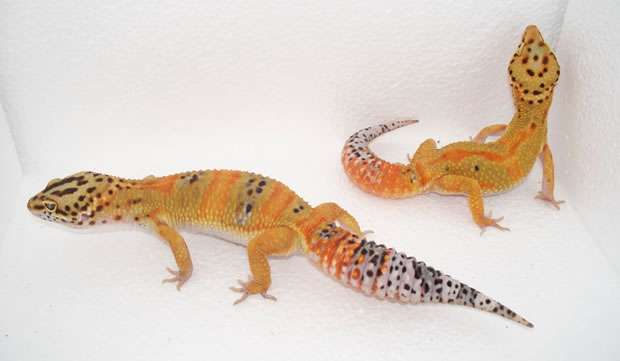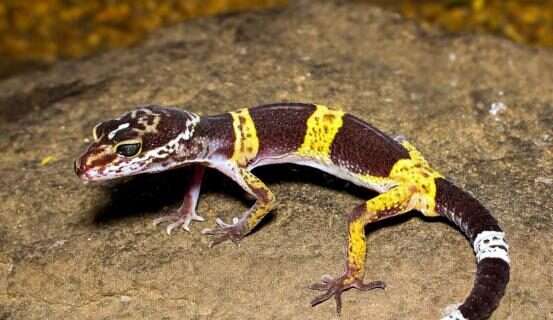
Description:
Scientific name: Eublepharis macularius
Life span: 15-20 years, occasionally up to 30 years
These well-known lizards are little, adorable, and do incredibly dumb things that make their owners adore them. A common tangerine leopard gecko morph features a tail with either spots or stripes and a brilliant orange back that varies in the specific shade of orange. Many individual have a tummy that is light in color with at least some patches.
Native Region/Habitat
In northwest India, Afghanistan, western Nepal, Pakistan, and certain parts of Iran, wild leopard geckos live in dry, rocky settings with scanty grassland and desert environments. In addition to rocky terrain with natural caves and crevices, they favour clay or sandy soils.
Behavior:
Leopard geckos in the wild tend to be nocturnal or crepuscular and stay out of the sun’s heat. They find refuge in the tunnels and cracks made by the rocky outcrops that are a common feature of their habitat. Leopard geckos are terrestrial lizards that rarely ascend; they rather prefer to stay on or below the ground.
There is little proof that leopard geckos in the wild establish free colonies. Nonetheless, those geckos have the capacity to leave and find some room. Leopard geckos kept in captivity lack the same chance.
Care As a pet/In captivity:

Tank: For a Leopard Gecko, a glass aquarium with a lid is excellent; an old, disused fish tank works well. A reasonable starting point is ten gallons per gecko and an additional five gallons for each gecko you add. Once a day, you should spot-clean the tank to get rid of any waste or uneaten food, and once a month, you should give it a thorough cleaning. To lessen the possibility of bacteria growth, remove everything from the cage, throw away the substrate, then clean and sanitize the cage and all of the accessories.
Lighting: Leopard geckos are nocturnal, so they don’t need a lot of UV illumination. However, as they are active at dusk and dawn in nature, a small quantity of UV light (2–7%) is advised. They will require an incandescent lamp to resemble sunlight and roughly 14 hours of light throughout the summer. During the winter, this can be lowered to 12 hours. A timer is a practical and affordable tool for maintaining regulated lighting.
Heating (Temperature & Humidity): In order for your gecko to select their preferred temperature, you must supply both a hot and a cool side inside of their cage. A heat lamp may easily create a hotter side of the habitat, but heat rocks are typically not advised because your gecko could get burned. Ideal temperature ranges for a basking area are around 88 degrees Fahrenheit during the day and a thermal gradient of about 75 degrees Fahrenheit across the rest of the cage at night.
As they are native to the desert, leopard geckos require an atmosphere that is between 30 and 40 percent humid. This is around the standard humidity level for the majority of households, and a mesh lid should aid in maintaining the humidity level. Your gecko will struggle to shed if the humidity is too low, so a hygrometer is an excellent addition to keep it under observation.
Feeding: Because leopard geckos are predominantly insectivores—that is, they only consume insects and no plants or vegetables—feeding them is straightforward. Geckos prefer eating live, gut-loaded crickets, though they will occasionally eat silkworms, mealworms, and waxworms as well. Your gecko will receive all the vitamins and minerals they require if you dust your crickets with powdered supplements.
Table




